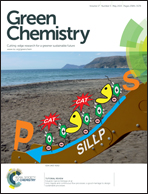A highly-efficient palladium-catalyzed aminocarbonylation/SNAr approach to dibenzoxazepinones†
Abstract
A convenient procedure for the synthesis of dibenzoxazepinones has been developed. Utilizing the protocol of one-pot palladium-catalyzed aminocarbonylation/aromatic nucleophilic substitution (SNAr) sequence, with 2-aminophenols and 2-bromofluorobenzenes as the substrates, the desired dibenzo[b,e][1,4]oxazepin-11(5H)-ones were prepared in moderate to excellent yields. The broad substrate scope and functional group tolerance of the reaction makes this approach a practical method for the synthesis of valuable dibenzoxazepinone and its derivatives. Mechanistic studies suggest that aminocarbonylation proceeds prior to SNAr.


 Please wait while we load your content...
Please wait while we load your content...